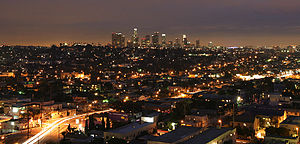 Image via WikipediaBy Cheryl Marland
Image via WikipediaBy Cheryl MarlandWhen we consider all the many forms of pollution, light pollution is almost always overlooked. A starless sky is taken for granted in the city, as residents rely on bright street lights and home flood lights for security and convenience.
According to a recent study performed by researchers at the National Oceanographic and Atmosphere Administration (NOAA), however, the cost of this safety and security is much higher than starless nights.
Many air toxins released in urban environments, like ozone, collect during the day and are dispersed at night through a series of chemical reactions in the atmosphere. The primary reactant studied, the nitrate radical, renders many toxins harmless, but it is inactivated by the sunlight. Though the lights used on homes, businesses and streets are nowhere near as powerful as the sun, the study shows that the nitrate radical is significantly impaired by them.
Measurements from the atmosphere over Los Angeles found the city's lights were responsible for decreasing nitrate radical formation by 7% and increasing the amount of ozone precursors by 5% the next day. This may not sound like much, but a large number of US cities are nearing or exceeding federal clean air guidelines already. The problem becomes more significant, when we consider that those metal halide and high-pressure sodium lights, the most common forms of street lighting, cause more pollution through nightly operation.
Light pollution also has a number of other effects uncovered in recent years. The mechanism behind a previously identified link between light pollution and an increase in breast cancer has been uncovered by researchers studying the effects of melatonin. Production of melatonin in the brain happens primarily in darkness, and melatonin was found to inactivate the effects of sex hormones on reproductive tissues. Many disorders, from prostate cancer to insomnia and PMS, are exacerbated when night-lighting decreases melatonin production.
This isn't a surprise given that animal breeding cycles are largely determined by the changing length of night during the year. Light pollution can cause serious problems to wildlife by disrupting breeding cycles and interfering with migratory patterns. According to researchers at Purdue, light also damages many common deciduous trees and shrubs, as these plants rely on the changing length of night as well.
Policy-makers, business owners, and individuals need to become aware of the costs of light pollution and make the necessary adjustments. There are immediate benefits to doing so, including lower energy bills and less fossil fuel pollution. Fixing this problem is as easy as turning out the lights, but it does not necessarily mean compromising on safety or convenience. Traditional lights can be exchanged for dark sky lighting, directed LED lights or directed at the ground, with extended-hood attachments, to reduce sky glare significantly.
Cheryl Marland is the publisher of Outdoor Lighting Choices.
People are concerned about making earth-friendly choices in all aspects of their lives, and outdoor lighting is no exception. Want to know how to find the perfect outdoor lighting that will meet all of your expectations for added security, decreased lighting pollution, reduced energy consumption, and above all, outstanding beauty? Stay up-to-date with dark sky and solar lighting news and look no further for dark sky compliant and quality solar outdoor lighting to meet all of your outdoor lighting needs.
Article Source: http://EzineArticles.com/?expert=Cheryl_Marland
http://EzineArticles.com/?Light-Pollution-Increases-Air-Pollution&id=6420169

No comments:
Post a Comment